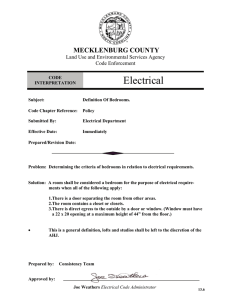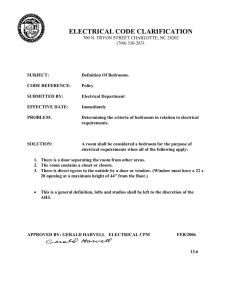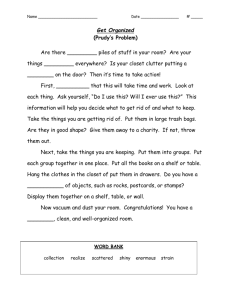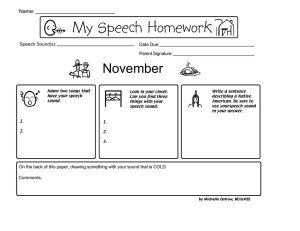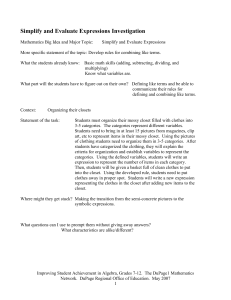Better Clothes Closets for ICUCM
advertisement
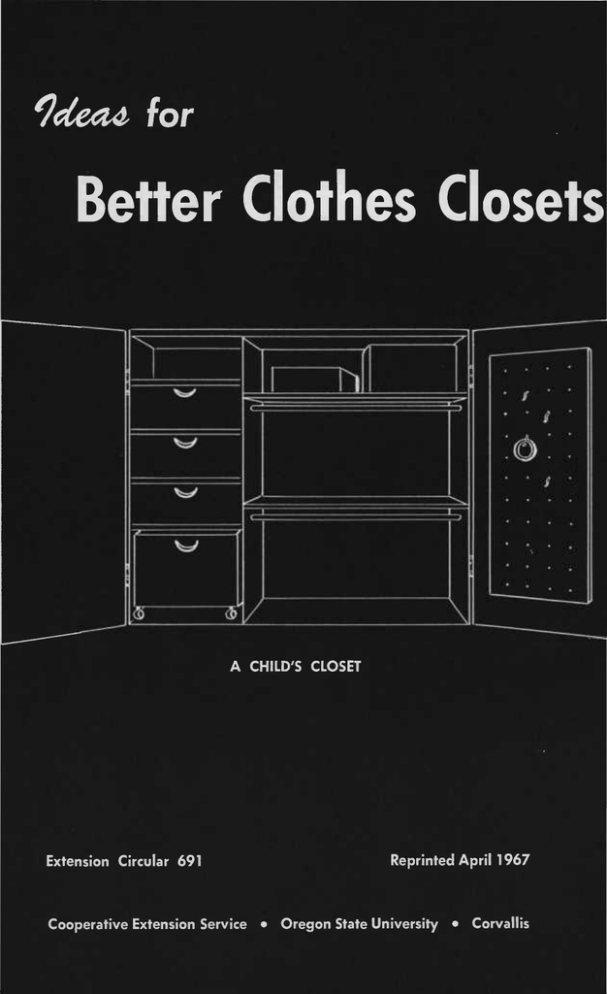
ICUCM for Better Clothes Closets A CHILD'S CLOSET Extension Circular 691 Reprinted April 1967 Cooperative Extension Service • Oregon State University • Corvallis Ideas for Better Clothes Closets BERNICE STRAWN Extension Home Management and Equipment Specialist Oregon State University Do You Really Need More Storage Space? The more storage space you have, the more you spread out. First decide if the items to be stored are worth the cost of additional closets. Perhaps nonessentials or seldom used items may be put in "dead storage" elsewhere. Costs of closets vary depending on whether you build them yourself or have them made by skilled workmen. Another closet without thought of how items are to be stored may do very little to relieve cluttered and crowded closets. Can You Make Present Closets Hold More? Ideas for making your present closets hold more may be a better solution. Good planning and organization will help stretch closet space. Some clothes can go on hangers, others on racks, shelves, or hooks. Add accessories so that space will suit the type of article stored. The cost of these improvements is very reasonable. When clothes do not get put back in their proper place, there is usually a reason. The item must be suited to the type of storage and be easy to reach and replace. You will find ideas here for ways to improve your present storage and ways to add more closets—whichever you decide you need. If You Need to Add More Closets Here are some possibilities to consider when you are looking for a place to add another closet. Use a portable closet Use space under the stairs Portable closets can be bought in various sizes and in a wide range of prices. Or you can.build the size to fit your needs. Portable closets can sometimes be used as room dividers to furnish privacy in a large room used by two or more people. Perhaps your house has a stairway under which a closet could be built. Or perhaps a closet could be hung above the foot of the stairs allowing plenty of headroom. Enclose a breezeway or porch Part of a breezeway or porch may be used to build a closet for out-of-season clothing. This additional storage space would make bedroom closets less crowded. BEFORE 1 Use space near windows Consider building closets on both sides of a window when the size of the room permits. A small chest can be used under the window between the closets. A similar arrangement (without the chest) could be planned for opposite sides of a door. DRAWERS AFTER i Build a storage wall r~i[~i ^M If the bedroom is large enough, you can build a closet 24 to 30 inches deep the full length of one wall and divide it into two or more closets. Or if practical, one closet can open into the adjoining room as shown in the drawing on the right. CLOSETI BEFORE CLOSET AFTER To Moke Your Closets Hold More For hanging clothes allow at least four feet of rod space per person. Plan space to fit clothes Have some clothes rod space higher than others. In the illustration on the left, short items hang on the lower rod allowing shelf space above. The average height needed for clothes to hang is as follows: Street dresses and coats Trousers, suits, blouses, and skirts 63 inches 39-45 inches Clothes for 3- to 5-year olds 30 inches Clothes for 5- to 12*year olds 45 inches Use more than one rod Use two rods in a closet for men's clothing. For a girl who wears skirts and blouses, two rods will save space, but part of the area will be needed for full length garments. If space permits, a section of sliding trays may be added for shoes, hats, flowers, purses, or folded clothes. n^ * 3 s Long Garments s Short Garments Skirts l I Long garments Blouses Jackets or If the rod cannot be changed, a chest of drawers may be placed under short clothes for the storage of miscellaneous items. Ways to stretch space ? O i* hfr MH ^h # JK m. IfV: # «sr r A special hanger will hold three pairs of trousers or three skirts. m ^ % % % ifn= A blouse rack will hold five blouses and will take the same space required for one blouse. 11 il II 11 If a closet is 30 inches or more deep, an over-thedoor rack will make good use of space and will hold several hangers. kLong Garments If you have a shallow closet, less than 24 inches deep, one or more extension rods can be used depending on the width available. Clothes hang on these rods parallel to the back of the closet, and a slight pull brings garments out for easy selection. Short Garments Shoes A roll-out shoe drawer can be made with vertical partitions. A similar drawer without partitions is handy for hats or for collecting laundry. Shoe racks can be placed below hanging clothes if space permits. A shoe rack can be easily made by using solid ends of a fruit box cut sloping at the top and joined by wooden strips. Chrome-plated shoe racks similar to the one illustrated here can be purchased if you wish. Add a portable step shelf either above or below clothes on hangers. If you wish, the shelf can be made shorter than the closet and tall items can be placed at the end. A rubber covered plate rack, available at hardware stores, can be used to store purses in a vertical position on closet shelves. Closet doors provide convenient storage If closet doors are hinged, the accessories described below bring many small items to your finger tips. A man's closet door is a good place to put up tie and shoe racks. Plastic or fabric shoe bags can be hung on closet doors, and a bag for personal laundry is also a convenience. Children's Closets Place hangers and shelves within easy reach of small children. Junior rods can be made by using any pole of suitable size and rope adjusted to the height of the child. yrn Aduit poie hhA. ^ Je§'lLia_a.e Pre-school A junior clothes rod hangs down 23 inches from grownup level. It is easy for children to hang up their own clothes if you have a junior rod. Short adult garments can hang above to double closet space. Closets can also be planned and built with rod supports at various heights. Rods can be adjusted as the child grows. Caps ^ Gloves Scarves P P P i1 The closet door is a handy place for shallow racks or bins to hold scarves, gloves, or caps. Doors can also be lined with pegboard and the space used to hang up such items as umbrellas and jackets. See the drawing on the front cover. Boxes stacked at one side in closets or in room comers provide shelf areas at various heights for storage of caps, hats, shoes, books, toys, games, etc. Out-of-season and seldom used articles can be kept on the higher shelves. 8 Coat Closets Closets for outdoor wraps near the entrance should be planned for use by guests. Four inches of rod space should be allowed for each coat. Provision also should be made for jackets, children's coats, hats, umbrellas, purses, and boots. Hots n n Long Coats Children's Coats Mglllgigilgl Jackets as well as long coats can be provided for by suspending a rod from the main clothes pole. A slotted wooden rack or shelf of hardware cloth about 6 inches above the floor will hold boots and rubbers. Aluminum foil, a plastic sheet, or heavy paper below will catch drips. Shelves at the sides can be used to hold purses, gloves, and hats. An umbrella rack may be constructed from wood slats attached to a closet door, and a hat rack above will hold two hats. Another type of rack for storing boots and galoshes can be made from a piece of 1" x 6" lumber and as many dowel rods as you have boots. The rods are held by holes bored in the lumber. This rack should be finished with enamel and placed on a plastic mat to protect the floor. in i U KJ 'J i A n■ n r U \J \J \j K, Ladies' or men's hats may be stored on hat stands made from coffee cans or round cereal cartons. These containers can be covered with shelf paper or decorative aluminum foil. 1 I I 1• • '11• J I I ' J ' J One wall of a closet door can be lined with pegboard and hardware attached for mounting shelves or hooks for hanging up purses, umbrellas, scarves, jackets, and other miscellaneous items. Work clothes can usually be hung on hooks to save space and low hooks are handy for the children's play clothes. Inside the closet door is a good place for a small mirror for quick make-up. A rack below is handy for purses and other belongings of guests or family members. The door should include vents if wet wraps are to be stored there. Other Home Management Publications' Better Kitchen Storage PNW 47 Storage For Your Home EC 679 Today's Soaps and Detergents PNW 36 Work Smarter—Not Harder EB 799 How to Prevent Moisture Damage in Your Home * Available from your county Extension agent's office. 10 PNW 90 Cooperative Extension work in Agriculture and Home Economics, Gene M. Lear, director. Oregon State University and the United States Department of Agriculture cooperating. Printed and distributed m furtherance of the Acts of Congress of May 8 and June 30, 1914.
